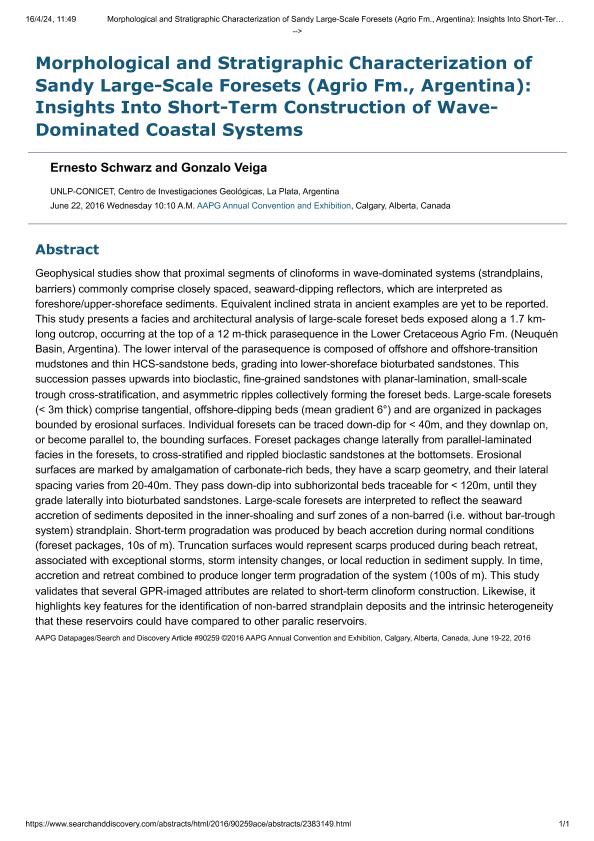Mostrar el registro sencillo del ítem
dc.contributor.author
Schwarz, Ernesto

dc.contributor.author
Veiga, Gonzalo Diego

dc.date.available
2024-04-18T10:35:00Z
dc.date.issued
2016
dc.identifier.citation
Morphological and stratigraphic characterization of sandy large-scale foresets (Agrio Fm., Argentina): Insights into short-term construction of wave-dominated coastal systems; AAPG 2016 Annual Convention and Exhibition; Calgary; Canadá; 2016; 1-1
dc.identifier.uri
http://hdl.handle.net/11336/233377
dc.description.abstract
Geophysical studies show that proximal segments of clinoforms in wave-dominated systems (strandplains, barriers) commonly comprise closely spaced, seaward-dipping reflectors, which are interpreted as foreshore/upper-shoreface sediments. Equivalent inclined strata in ancient examples are yet to be reported. This study presents a facies and architectural analysis of large-scale foreset beds exposed along a 1.7 km-long outcrop, occurring at the top of a 12 m-thick parasequence in the Lower Cretaceous Agrio Fm. (Neuquén Basin, Argentina). The lower interval of the parasequence is composed of offshore and offshore-transition mudstones and thin HCS-sandstone beds, grading into lower-shoreface bioturbated sandstones. This succession passes upwards into bioclastic, fine-grained sandstones with planar-lamination, small-scale trough cross-stratification, and asymmetric ripples collectively forming the foreset beds. Large-scale foresets (< 3m thick) comprise tangential, offshore-dipping beds (mean gradient 6°) and are organized in packages bounded by erosional surfaces. Individual foresets can be traced down-dip for < 40m, and they downlap on, or become parallel to, the bounding surfaces. Foreset packages change laterally from parallel-laminated facies in the foresets, to cross-stratified and rippled bioclastic sandstones at the bottomsets. Erosional surfaces are marked by amalgamation of carbonate-rich beds, they have a scarp geometry, and their lateral spacing varies from 20-40m. They pass down-dip into subhorizontal beds traceable for < 120m, until they grade laterally into bioturbated sandstones. Large-scale foresets are interpreted to reflect the seaward accretion of sediments deposited in the inner-shoaling and surf zones of a non-barred (i.e. without bar-trough system) strandplain. Short-term progradation was produced by beach accretion during normal conditions (foreset packages, 10s of m). Truncation surfaces would represent scarps produced during beach retreat, associated with exceptional storms, storm intensity changes, or local reduction in sediment supply. In time, accretion and retreat combined to produce longer term progradation of the system (100s of m). This study validates that several GPR-imaged attributes are related to short-term clinoform construction. Likewise, it highlights key features for the identification of non-barred strandplain deposits and the intrinsic heterogeneity that these reservoirs could have compared to other paralic reservoirs.
dc.format
application/pdf
dc.language.iso
eng
dc.publisher
American Association of Petroleum Geologists

dc.rights
info:eu-repo/semantics/openAccess
dc.rights.uri
https://creativecommons.org/licenses/by-nc-sa/2.5/ar/
dc.subject
SANDY LARGE-SCALE FORESETS
dc.subject
AGRIO FM.
dc.subject
MORPHOLOGICAL AND STRATIGRAPHIC CHARACTERIZATION
dc.subject
WAVE-DOMINATED COASTAL SYSTEMS
dc.subject.classification
Geología

dc.subject.classification
Ciencias de la Tierra y relacionadas con el Medio Ambiente

dc.subject.classification
CIENCIAS NATURALES Y EXACTAS

dc.title
Morphological and stratigraphic characterization of sandy large-scale foresets (Agrio Fm., Argentina): Insights into short-term construction of wave-dominated coastal systems
dc.type
info:eu-repo/semantics/publishedVersion
dc.type
info:eu-repo/semantics/conferenceObject
dc.type
info:ar-repo/semantics/documento de conferencia
dc.date.updated
2024-04-11T21:03:47Z
dc.journal.number
90259
dc.journal.pagination
1-1
dc.journal.pais
Canadá

dc.journal.ciudad
Calgary
dc.description.fil
Fil: Schwarz, Ernesto. Consejo Nacional de Investigaciones Científicas y Técnicas. Centro Científico Tecnológico Conicet - La Plata. Centro de Investigaciones Geológicas. Universidad Nacional de La Plata. Facultad de Ciencias Naturales y Museo. Centro de Investigaciones Geológicas; Argentina
dc.description.fil
Fil: Veiga, Gonzalo Diego. Consejo Nacional de Investigaciones Científicas y Técnicas. Centro Científico Tecnológico Conicet - La Plata. Centro de Investigaciones Geológicas. Universidad Nacional de La Plata. Facultad de Ciencias Naturales y Museo. Centro de Investigaciones Geológicas; Argentina
dc.relation.alternativeid
info:eu-repo/semantics/altIdentifier/url/https://www.searchanddiscovery.com/abstracts/html/2016/90259ace/abstracts/2383149.html
dc.relation.alternativeid
info:eu-repo/semantics/altIdentifier/url/https://www.searchanddiscovery.com/abstracts/html/2016/90259ace/
dc.conicet.rol
Autor

dc.conicet.rol
Autor

dc.coverage
Internacional
dc.type.subtype
Exposición
dc.description.nombreEvento
AAPG 2016 Annual Convention and Exhibition
dc.date.evento
2016-06-19
dc.description.ciudadEvento
Calgary
dc.description.paisEvento
Canadá

dc.type.publicacion
Journal
dc.description.institucionOrganizadora
American Association of Petroleum Geologists
dc.description.institucionOrganizadora
Society for Sedimentary Geology
dc.source.revista
AAPG Annual Convention and Exhibition: Abstract
dc.date.eventoHasta
2016-06-22
dc.type
Exposición
Archivos asociados
